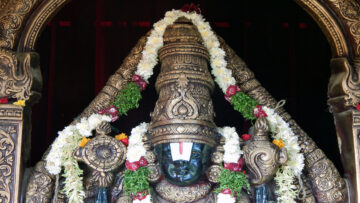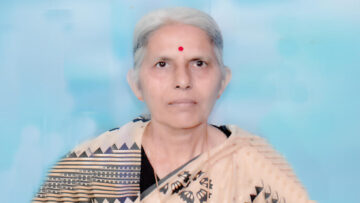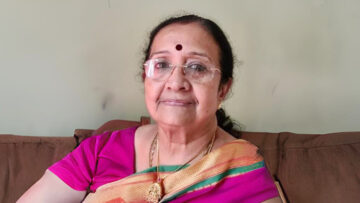Shalini Mahapatra’s book “Shri Jagannath Mahaprasad Legends Miracles Myths”, gives us interesting information about the most famous Prasad of any Hindu shrine. According to the Skanda Purana, Lord Jagannath redeems devotees by permitting them to partake his Mahaprasad, to have his darshan and worship Him by rituals and by offering gifts.
The Puri Jagannath temple kitchen has the capacity to cook for one lakh devotees on a single day. Mahaprasad is cooked only in earthen pots and on hearths. The steam-cooked food is offered to Lord Jagannath first and then to Goddess Bimala after which it becomes Mahaprasad. The items offered include cooked rice, dal, vegetable curry, sweet-dishes, cakes etc. Dry confectionaries are prepared of sugar, jaggery, wheat flour, ghee, milk etc. The temple website says that when the steam-cooked food is carried to the Lord in slings of earthen pots, no flavour comes up from the food but when the same is carried back to the sale point after being offered to the Lord a delicious smell wafts through.
Shalini Mahapatra was a recipient of an Indica Fellowship to study the Mahaprasad of Puri Jagannath temple.
(Figure 1: Mahaprasad getting cooked in earthen pots using firewood)
What inspired you to write a book on the Mahaprasad of the Jagannatha Temple?
As an armed forces kid, I grew up gathering Bharat in my memories and nurturing myself to be a Bharatiya because of my father’s frequent transfers across the country every two to three years. Annual vacation to my domicile state Orissa would keep us connected to our native culture. A very important part of these vacations was a mandatory visit to the Shrimandira of Shri Jagannath at the mool dham in Puri. This temple visit would end only after partaking in the Mahaprasad within the temple premises at Anand Bazar. After the annual Mahaprasad sevan, there would be an episode of packing a good amount of dried Mahaprasad and small packets of Nirmalya that would be taken back for distribution for my father’s regiment and among friends. The Mahaprasd was something that I would never get to eat anywhere until the next visit to Puri. These annual memories of Mahaprasad made me curious about it. Inquisitively I searched for literature on the food offered at Puri Dham. I failed to get satisfactory information in English as most of it was available in Odia language books and I being a fauji kid had not studied the vernacular Odia language. Thankfully, I could speak the Odia language fluently so, I started gathering information about the Mahaprasad by talking to the locals of Puri, Sevakas, Jagannath Sanskruti scholars, researchers and former administrative officers of the Shri Jagannath Temple Trust. Subsequently, I published my research on Mahaprasad – “Shri Jagannath Mahaprasad Legends Miracles Myths”, a book in the English language on various aspects of Shri Jagannath temple cuisine . The objective was to disseminate information on the culture of Shri Jagannath and the temple food culture beyond the margins of Orissa.
(Figure 2: Mahaprasad cooked and ready to offer to Shri Jagannath)
What traditional aspects of Oriya cuisine can we find in the recipes used?
The local vegan cuisine of Orissa is very much in harmony with the Jagannath temple cuisine. Rice is majorly consumed throughout the state. Odia food in general is not very rich, it is simple, wholesome and nutritious, and so is the Mahaprasad. Another interesting aspect is related to the strict sourcing and preparation of local and Indian agricultural produce cultivated in and around the ancient Prachi Valley civilization which lies partly in modern-day Puri, Cuttack and Khurda district. Most of the food offerings done in the Shri Jagannath temple are also prepared in local households of Orissa with certain modifications in ingredients.
The recipes include the use of rice,dairy products, jaggery and local vegetables and fruits. Mustard seeds, ginger, cumin, black pepper, and coconut are sufficiently used. As per the Kapila Samhita a list of vegetables that are restricted to be used in the preparation of Mahaprasad includes potato, tomato, boiled rice, dried chilli, oil, bitter gourd, cabbage, cauliflower, onion, garlic, snake gourd, long gourd (lauki), lady’s finger, long beans, drumsticks, beans and carrot. Refined sugar, salt and oil cannot be used either. The dishes are prepared with the commonest local herbs and spices, thus making the Mahaprasad a commoners’ delight.
Here it is pertinent to mention that Shri Jagannath temple is also a Shakti Peeth with Goddess Bimala enshrined in the temple premises.During Durga Puja, Goddess Bimala is offered fish that is called Bimalaparusa.
There is a long list of such recipes that are common to the Shri Jagannath temple cuisine and the local Odiya kitchen.
The prasad has great antiquity and has remained unchanged despite people’s changing tastes and is immensely popular. What accounts for this?
The Mahaprasad of Shri Jagannath is one of the oldest cuisine cultures of the world with its beginning linked to Satya Yuga which makes it almost 7000 years old. It is believed that Lord Vishnu has incarnated himself as Lord Jagannath and dines at Puri. Divine dining has been a ritualistic practice since the construction of the present temple in 12th century AD.The popularity of Shri Jagannath Mahaprasad, I would say, is rooted in undisputed faith in Maha Prabhu Shri Jagannath. It is believed that the food served to Shri Jagannath is savoured by his eyes. He is said to taste the food through the tongue of his devotees, making the food an integral part of linking the Divine and humans. The other factors include its easy availability 24/7, throughout the year at an affordable cost. It has a distinct flavoursome yet neutral taste and offers a vast assortment to choose from.
Is one family responsible for preparing the Mahaprasad? How has learning been passed on? Do we have any academic or shastric texts on which this tradition is based?
It is believed that the food in the Shrimandira is cooked by Devi Mahalakshmi and served to Shri Jagannath and his siblings. The Suaras remain the official cooking assistants to Goddess Mahalakshmi in the Pakashala– Godly Kitchenette. Suaras, (a corrupt Odia word, derived from the Sanskrit word ‘Supakar’, meaning ‘cooks’) are involved in the preparation of the temple cuisine. As per legend, Lord Brahma had assigned the task of cooking to the Suaras who are the descendants of a Brahmin emissary named Bidyapati and his Shabara wife Devi Lalita. The recipes and the cooking technique are passed on from one generation of the Suaras to the other through practical teaching. Some texts that give insights into the food rituals of Shri Jagannath are ‘Bamadeva Samhita’, ‘Srimandira Swattwalipi’, ‘Niladri Mahodaya’, ‘Kapila Samhita’ and ‘Madala Panji’.
Unlike most temple prasad, the scale and variety here are not to be found in any other place. Could you please describe briefly the range of offerings?
The Jagannath temple of Puri has three kitchens. The main kitchen roughly covers an acre and has 32 rooms with a dedicated courtyard for cutting vegetables and grinding purposes, making it the largest Divine kitchen in the world. The kitchen stocks an astonishing 752 wood-burning clay stoves. The routine of offering food to Shri Jagannath at the Shrimandira is traditionally called Dhupa which usually starts at around 8:30 a.m. and continues to around midnight. The concluding Dhupa is the bedtime ritual of the Gods, popularly known as the Bada Shringara Besha. There are six particular times throughout the day when the Gods are offered food.
There is a famous proverb that says
“षदरसव्यन्जननानायति छप्पन्भोगोलगेदीनौरति“
“Sada rasa Vyanjana Na na Yati Chappan Bhogo Lage Dinarati”
Meaning: “Many dishes with all the six tastes, fifty-six items of bhogos are offered day and night”.
The Gods are served with a popular assortment of 56 food items known as the ‘Chhappan Bhogo’ but the list has more to it.
According to the Deula Karana– the temple record keeper, the present-day Kotho Bhoga list has around 86 dishes out of which around 64 varieties of food preparation continue to be done. Apart from these 64 specific dishes served daily, the number of dishes goes up to around 84 on festive occasions.
On average, around 10,000 consume the Mahaprasad daily. On festive occasions, the count increases to around 25,000 and beyond.
(Figure 3: Puri Jagannath temple, pic courtesy Martin Gray, Sacredsites.com)
What are some of the rituals involved in the making and offering of the food?
The daily Pakashtala Vidhi begins with the Rosa Homa. The fire in the Shrimandira kitchen is known as “Vaishnava Agni”, and it is never put out. The customary offering of food to the Gods is traditionally called Dhupa when it is done by following ‘Sodasa Upacharas’ (rituals) or the 16 rituals. It is termed Bhogo when the offering is done following Pancha Upacharas – the 5 rituals.
How is the Anna danam connected to the prasadam?
Mahaprasad is Anna Brahma -The life force in the rice we consume. It is said that by the intake of the Mahaprasad, we take Him and get His blessings. It is also believed that in the Kali Yuga, man would feed himself on Anna or rice which was uncommon to other yugas. The consumption of Anna or rice being huge in the Jagannath temple, accompanied by huge donations of rice (Anna Daan) makes Puri the Anna Kshetra (Rice area). It is the only temple in India and elsewhere on the planet where such a huge amount of rice is offered as Prasad and served as Mahaprasad.
In very early South Indian Temple traditions certain dishes could only be made in temples or by royal households to be offered to the deity and people could partake of it as prasadam. One example was Payasam. Later it became common to make it at home. Is this something that could happen to the offerings at Puri Jagannatha Temple?
Much sought delicacies like Bundi laddu, Bundia, Besan Laddu, Rasagolla, Khowa, Kheer, Sweet Curd, Malpua (Amalu), Rabidi, Gajja, Sweet Dal, Curd Rice (Dahi Pakhala), Khechudi (Khichdi), Sweet Rice (Kanika), Vada, Dahi Vada, Lemon Rice (Odia Anna), Dosa (Chakuli), Idli (Enduri), Appam (Chittou), Mixed Veg Dal (Dalma) and more, are part of the Divine cuisine list in the Shrimandira. All these dishes, much recognised as part of other Indian cuisines have their epicurean history rooted in the ancient Jagannath food culture which as per records can be taken to the 12th century AD when the present temple was built or even beyond.
Do you have any anecdotes related to the making of the prasad?
The food offerings made in all Sanatan temples are referred to as Prasad except in the Shrimandira at Puri where it is referred to as ‘Mahaprasad’. There is a legend behind the reoffering of Jagannath’s prasad to Goddess Bimala, which otherwise is considered taboo. As per legend Lord Shiva once visited Vishnu at Vaikunta. He saw that a few foodgrains fell on the ground after Vishnu had finished his meal. Lord Shiva then picked up a grain of the fallen foodgrains and swallowed it. However, another grain was stuck onto his beard. Dev Rishi Narada saw it. He plucked it from Lord Shiva’s beard and ate it. This angered Devi Parvati who felt that she should have been offered the grain as she is the other half of Lord Shiva. She then came to Vishnu and complained about it. Vishnu pacified her, saying that in the Kali Yuga, she would live at Puri as Goddess Bimala, and would consume the remnants of the food offered to him. In the Jagannath temple, Puri, the food is offered to the Triad- Shri Jagannath, Shri Balabhadra and Devi Subhadra at the main altar and becomes prasad. This prasad is then taken to Goddess Bimala and offered where it becomes Mahaprasad. Thereafter it is taken out to the Ananda Bazar for the consumption of devotees. (There are several versions of the above legend)
(Figure 4: Puri Jagannath Ratha Yatra painting, Courtesy: Martin Gray, Sacred Sites)
What are the lores connected to the deities and the prasadam?
According to legend Shri Jagannath leaves his wife Devi Mahalakshmi at the Shrimandira, while he goes to the Gundicha temple along with his siblings for a ten-day sojourn during the Rath Yatra festival. On His return, Goddess Lakshmi expresses her annoyance by preventing the entry of Shri Jagannath and his siblings into the temple. To appease Devi Mahalakshmi, Shri Jagannath offers her ‘Rasagollas’-soft cottage cheese roundels dipped in sweet syrup and persuades her to grant Him forgiveness for his absence. After prolonged persuasion, she allows Shri Jagannath and his siblings entry inside the Shrimandira premises. This barter of rasagollas also marks a sweet ending to the annual Ratha Yatra festivity. This tradition of offering Rasagolla on the day of Niladri Bije is around 600 years old.
Is the food made in a special utensil using some special method?
The indigenous Sauribidhi cooking technique is still followed in the Rosa Graha of Shri Jagannath temple. The cooking technique used in the preparation of the Mahaprasad is also called ‘Abhada’. In the tribal ‘Saura’ language spoken by the Shabaras, ‘Abhada’ means – the act of boiling something in water. On the request of Adi Shankaracharya to the king, the arrangement of offering boiled rice to Shri Jagannath was made. The same antique technique of boiling and cooking is being followed in the Godly Kitchen of Shri Jagannath till date. The cooking technique is based on the transfer of heat through steam. When the stacks of earthen urns are put on wood lit fire, the heat is transferred as steam. The steam helps to cook the food evenly and earthen urns keep the food warm for a long period.
Disclaimer: The opinions expressed in this article belong to the author. Indic Today is neither responsible nor liable for the accuracy, completeness, suitability, or validity of any information in the article.












